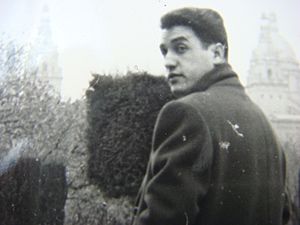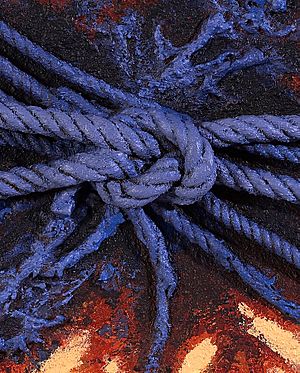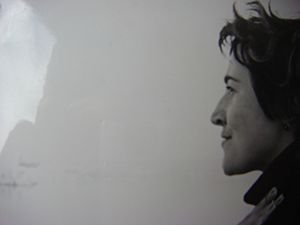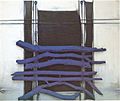Laurent Jiménez-Balaguer facts for kids
Quick facts for kids
Laurent Jiménez-Balaguer
|
|
|---|---|
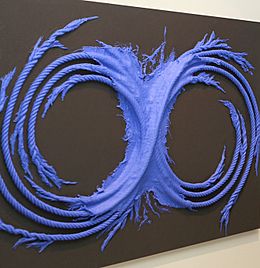
Jiménez-Balaguer From Infinity to Infinity 2011
|
|
| Born |
Llorenç Jiménez-Balaguer
14 January 1928 |
| Died | 16 April 2015 (aged 87) |
| Nationality | Hispanic |
| Known for | painting |
|
Notable work
|
Clotted Memory, Through the Mirror N°23, The Crack of the World, What's hiding ? |
| Movement | Abstract Expressionism, Informalism, Humanism, Poststructuralism, Postmodernism, New Informalism |
Laurent Jiménez-Balaguer (born January 14, 1928 – died April 16, 2015) was a Spanish painter. He was born in L'Hospitalet del Llobregat, near Barcelona, Catalonia, Spain. Later, he lived and worked in Paris, France.
In the 1950s, he became a well-known painter in Catalan art. He was part of art movements like Abstract Expressionism and European Informalism. These styles focused on expressing feelings and ideas through abstract shapes and textures.
Jiménez-Balaguer wanted to show how painting could help people understand themselves. He believed that our inner self is real and important. He thought art could make this inner world visible.
His art explored the idea that we create who we are through our actions. A famous art critic, Jose María Moreno Galván, called him one of the most talented Catalan painters in 1960. His work often focused on two main ideas: the "Body-Memory" (our physical self and past experiences) and the "Exterior-Interior" (the world outside and our inner thoughts).
Contents
Early Life and Art Exploration
In his early years, Jiménez-Balaguer painted figures that seemed to have a deep, spiritual meaning. His portraits focused on what was inside a person, rather than their gender or culture. Like the famous painter El Greco, he wanted to show the true essence of a person.
Around 1955, he stopped painting realistic scenes. Instead, he focused on how to make invisible feelings visible through art. He believed painting was a way to truly know oneself. He thought art could show our raw, inner thoughts.
Jiménez-Balaguer believed that all art expresses something. He felt that art creates meaning and connects everything. This led to his idea of an Other Reality. This reality exists between our inner world and the outer world, and between our body and our memories.
He helped define this "Other Reality" as a special kind of artistic sign. During these years, Spain was under a strict government. Jiménez-Balaguer actively supported Catalan identity. He learned to write in Catalan, which was forbidden at the time. He experimented with showing the hidden, fragile parts of the human mind. He believed that what we feel inside is a reflection of deeper truths.
Catalan Lyrical Abstraction
When he was twenty, Jiménez-Balaguer went to the Montserrat mountains. There, he painted with his friend, Josep Guinovart. They felt a new sense of freedom in their art. He also became good friends with Cesáreo Rodríguez-Aguilera and his wife.
He wrote a statement called "He Escuchado" (I Have Listened). In it, he said that art should help people express universal truths. He agreed with thinkers who believed the human body shows the human soul.
His paintings helped make the Catalan art scene richer. He got support from famous artists like Manolo Millares and César Manrique. Their goal was to make sure artists could express themselves freely. In 1956, he was recognized as part of the Art Informal movement.
At this time, Catalan artists wanted to create their own unique art style. They were against the official art approved by the government. Artists like Joan Miró also pushed for new forms of art. In 1957, Jiménez-Balaguer and other artists like Antoni Tàpies showed their new works. These artists used Informalism to criticize a world that felt unfair and oppressive.
Informalism and Information
In the 1970s, Jiménez-Balaguer continued to explore how art could help us understand ourselves. His work began to focus on how humans express themselves, and the things that stop them, like shyness or rules. His paintings showed the unknown parts of our inner world.
Even though his art was abstract, he believed it wasn't mysterious. He thought it should communicate meaning. He felt that art should give people information that helps them feel more powerful.
The word "inform" in Catalan means "without form." But Jiménez-Balaguer also looked at another meaning: to give detailed information about a topic. So, for him, Informal meant sharing information that hadn't yet taken a clear shape. He saw Informalism as the art style that shows where meaning is created.
Defending Our Inner Selves
Jiménez-Balaguer's art showed deep respect for how sensitive and vulnerable we can be. He criticized modern society for sometimes harming our inner selves. During these years, he focused on painting's power to make a difference.
He believed that informalist art held a memory of early, pre-symbolic ways of thinking. He moved past the harsh, scratched styles of post-war Informalism. He wanted his art to look towards the future.
His art showed that even after difficult experiences, the human mind can heal and rebuild itself. Jiménez-Balaguer's main goal was to turn difficult feelings into beautiful art forms.
Creating a Universal Language of the Self
In the 1960s, Jiménez-Balaguer and his wife, María Teresa Andreu, moved to Paris. They became part of the city's intellectual art scene. They had four children: Cristian, Virginie, Valérie, and Eric.
He met other artists and gallery owners. For the next twenty years, he worked on creating a language of signs. He wanted these signs to communicate the universal feelings of the "Self." He challenged the idea that our inner thoughts can't be understood by others.
Jiménez-Balaguer believed that our inner world is meant for everyone to understand. In 1986, he met Michel Tapié, who created the idea of "Art Autre" (Other Art).
From 1988 onwards, he started adding everyday objects to his paintings. These objects, like branches, ropes, cloth, grids, and nails, helped express inner feelings.
Painting as a Way to Connect
Jiménez-Balaguer's work gained support from important art critics. He also met other artists like Joan Hernández-Pijuan.
From 1990, he developed a system of signs for a universal language of the inner self. Each painting became a space where this universal language could be seen. His art explored big questions about what makes us who we are, like time, memories, and suffering.
In 2000, he began talking about art and philosophy with Alexis Virginie Jimenez. Together, they started a new art movement called New Informalism. This movement began in his studio in France. Their ideas were based on new ways of studying culture.
Jiménez-Balaguer's art shared ideas with important thinkers like Julia Kristeva and Jacques Derrida. He questioned traditional ideas about human identity. He wanted to find new ways to understand who we are.
Artwork: Universal Graphic Symbols
The ropes: These symbolize the connections between our invisible inner self and the whole universe. Ropes showed the path the artist took into the world of "Art Autre."
Blue branches: These represented the journey of the soul and how it finds its complete form.
The knots: These were like mental marks or ideas that showed how our inner thoughts are formed.
See also
- Informalism
- Western painting
Individual Exhibitions
- 2012
Cicle Invasions Subtils amb Laurent Jiménez-Balaguer, Fundació Espai Guinovart, Agramunt – CATALONIA – SPAIN
- 2012
L’Emergència del Signe, Museo Can Framis, Fundació Vila Casas, Barcelona – CATALONIA – SPAIN
- 2010
"El Cos d’una memòria", Galeria Art Vall, Andorra la Vella – ANDORRA
- 2010
"Le Nœud", Galerie Saint Cyr, Rouen – FRANCE
- 2007
"Cuerpo de una memoria", Galeria Calart Actual, Segovia – SPAIN
- 2006
"L'au-delà du miroir", Galerie Guislain-États d'Art, Paris – FRANCE
- 2003
"Œuvres de 1960 à 1962" et "Souvenirs enfouis", Rétrospective, Galerie Guislain-États d'Art, Paris – FRANCE
- 2002
"Traces d'une mémoire", Centre d'Études Catalanes, Paris – FRANCE
- 2000
"Exposition", Galerie Guislain-États d'Art, Paris – FRANCE
- 1999
"2000 ans de quoi ?", Galerie Lina Davidov, Paris – FRANCE
- 1999
"2000 ans de quoi ?", Grand Théâtre d’Angers, Angers – FRANCE
- 1998
"Dedans/Dehors", La Corderie Royale, Rochefort – FRANCE
- 1998
MPT Courdimanche, Les Ulis – FRANCE
- 1997
"Images d'une mémoire", Les Cordeliers, Châteauroux – FRANCE
- 1997
Galerie Lina Davidov, Paris – FRANCE
- 1996
Galerie Finartis, Zug – SWITZERLAND
- 1995
Galerie Calart, Genève – SWITZERLAND
- 1994
Galerie Rami, Zurich – SWITZERLAND
- 1994
Galerie Lina Davidov, Paris – FRANCE
- 1993
Galerie Adriana Schmidt, Cologne – GERMANY
- 1992
Galerie Lina Davidov, Paris – FRANCE
- 1992
Galerie Adriana Schmidt, Stuttgart – GERMANY
- 1991
Centre d'Art Contemporain, Corbeil-Essonnes – FRANCE
- 1991
Galerie Claude Samuel, Paris – FRANCE
- 1991
Galerie Rami, Zurich – SWITZERLAND
- 1990
Galerie Calart, Genève – SWITZERLAND
- 1989
Galerie Claude Samuel, Paris – FRANCE
- 1987
"Réalité autre", Galerie Claude Samuel, Paris – FRANCE
- 1985
Paris Art Center, Paris – FRANCE
- 1984
Grand Orient de France, Paris – FRANCE
- 1982
International Arts Gallery, Chicago – UNITED STATES
- 1981
Galerie Vienner, Paris – FRANCE
- 1980
Galerie Vienner, Paris – FRANCE
- 1980
Musée Napoléonien, Antibes-Golfe-Juan – FRANCE
- 1979
Galerie Vienner, Paris – FRANCE
- 1977
Réalisation de huit grandes créations murales pour le Centre Hospitalier de Creil, Creil – FRANCE
- 1969
Dayton's Gallery 12, Minneapolis – UNITED STATES
- 1963
Joachim Gallery, Chicago – UNITED STATES
- 1961
Galerie Saint-Germain, Paris – FRANCE
- 1961
Savage Gallery, London – UNITED KINGDOM
- 1961
Galerie Toulouse, Copenhagen – DENMARK
- 1959
Galerie J.C. de Chaudun, Paris – FRANCE
- 1959
Galerie Mistral, Brussels – BELGIUM
- 1959
Centre Culturel et Artistique d'Uccle, Brussels – BELGIUM
- 1957
Club Universitari de València, Valencia – SPAIN
- 1957
Galeria d'Art Jaimes, Barcelona – CATALONIA – SPAIN
- 1956
Galeria Clan, Madrid – SPAIN
- 1956
Galeria d'Art Quint, Palma de Mallorca – Balearic Islands – SPAIN
- 1955
"Ciclo Experimental d’Art Nou", Galeries Jardin, Barcelona – CATALONIA – SPAIN
- 1955
Casino de Ripoll, Ripoll – SPAIN
- 1955
Galeries Laietanes, Barcelona – CATALONIA – SPAIN
- 1955
Galeria Sur, Santander – SPAIN
Museums and Public Collections
- Museu de l’Hospitalet, Barcelona – Spain
- Museu de Montserrat, Barcelona – Spain
- Fundació Vila Casas, Barcelona – Spain
- MACBA, Museu d’Art Contemporani, Barcelona – Spain
- Fons d'Art de la Generalitat de Catalunya, Barcelona – Spain
- Museu de Ceràmicas, Manises – Spain
- Artecovi, Fundación, Madrid – Spain
- Musée de Chateauroux, France
- Musée municipal de Bourg-en-Bresse, France
- Musée d’Art et Histoire, Rochefort – France
- Grand Théâtre (Angers), France
- Centre d'art sacré contemporain de Lille, France


